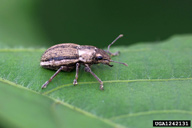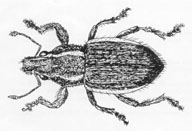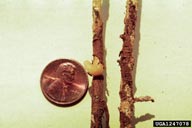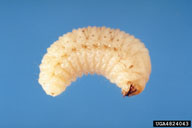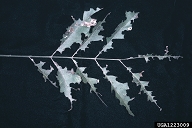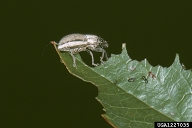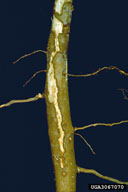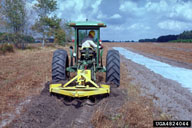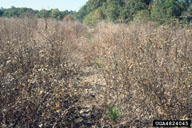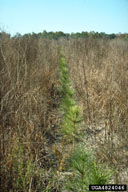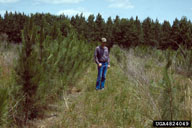Whitefringed beetles
(Naupactus spp.) (Coleoptera: Curculionidae)
Orientation to pest
Whitefringed beetles, formerly regarded as a separate genus (Graphognathus), are now an informal "species group" within a much larger genus (Naupactus). The name whitefringed beetle comes from the white lines that run the length of the grey-to-brown body, two on each side, one above and one below the eye. There are four species, all invasive, in the United States: Naupactus leucoloma (Boheman), N. peregrinus (Buchanan), N. minor (Buchanan), and N. fecundus (Buchanan). These beetles are pests of various agricultural crops, but also injury young pine seedlings when trees are planted into converted farmland in the southern United States. Adults feed on the foliage of hundreds of plant species, but damage is of minor importance. Larvae feed on roots and their damage is more serious, especially on crops or young pines in plantations and nurseries. Like the adults, the larvae feed on a diverse set of hosts, athough their full host range is more difficult to document. The U.S. populations of all four species contain only females, athough populations with males are found in the native range in southern South America. Adults have fused wing covers and cannot fly. Eggs are laid in masses on objects on or near the soil. Larvae drop into the soil where they feed on roots and then and pupate in earthen cells where they overwinter. There is only one generation per year.
Hosts commonly attacked
Adults feed on nearly 400 species of plants, including many crops. Larvae feed on roots of some trees, such as peach (Prunus persica [L.] Batsch), pecan (Carya illinoinensis [Wangenh.] K.Koch), tung (Vernicia fordii [Hemsl.] Airy Shaw), willow (Salix), and pine (Pinus).
Distribution
Originally from southern South America (Argentina, Peru, Chile, Uruguay), whitefringed beetles are found as invasive species in the United States from Florida north to Virginia and Illinois and west to Texas.
Images of whitefringed beetles
| Figure 1. Adult of one of the whitefringed beetles, Naupactus peregrinus; see the enhanced white lines in drawing on right | Figure 2. Larva of a species of whitefringed beetle in root (left) and close up (right) | ||
| Figure 3. Feeding damage of adult whitefringed beetles (left), and close up of adult feeding on blueberry leaf (right). | Figure 4. Feeding damage of larvae of whitefringed beetles on root of sycamore tree | Figure 5. "Scalping" is the use of machinery to remove a thin layer of thatch and top soil before planting a new block of pine seedlings | |
| Figure 6. Unscalped pine plantation (left), showing loss of seedling establishment vs. scalped plot (right), where whitefringed beetles have been removed and pine seedling survival increased. | Figure 7. Scalped plot (left of man) vs unscalped plot (right of man) in slash pine (Pinus elliottii Engelm.) plantation, showing cumulative effect of larvae of whitefringed beetles on growth of slash pines when beetle are suppressed before planting via "scalping" (removal of thatch and bit of top soil just before planting) or not. | ||
Important biological control agents related to this pest species
No information was located on specialized natural enemies of this group of beetles.
Web links for information on whitefringed beetles
- Fact Sheet | University of Queensland, Australia
Provides information on recognition, biology, ecology, and control - Quarantined Pest Data Sheet | European & Mediterranean Plant Protection Organization
- Featured Creature Fact Sheet | University of Florida and FDACS
Articles
- Anderson W. H. 1938. A key to separate the larvae of the white-fringed beetle, Naupactus leucoloma Boh., from the larvae of closely related species. USDA Bureau of Entomology and Plant Quarantine Circular E-422. 3 p.
- Ahmad, R. 1974. Studies on Graphognathus leucoloma (Boh.) Col.: Curculionidae) and its natural enemies in the central provinces of Argentina. Technical Bulletin No. 17, Commonwealth Institute of Biological Control, pp. 19-28.
- Harlan, D. P. and J. W. McGuire. 1977. Separation of four species of whitefringed beetles by measuring the length and width of the eggs (Coleoptera: Curculionidae). Journal of the Georgia Entomological Society 12: 125-128.
- Lanteri, A. A. and A. E. Marvaldi. 1995. Graphognathus Buchanan a new synonym of Naupactus Dejean and systematics of the N. leucoloma species group (Coleoptera: Curculionidae). Coleopterists Bulletin 49(3): 206-228.
